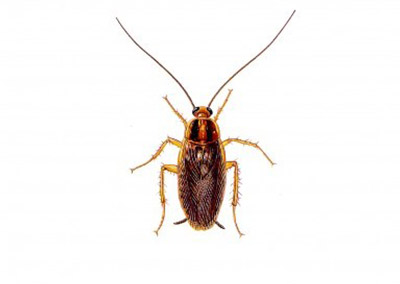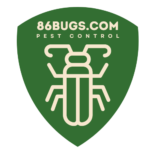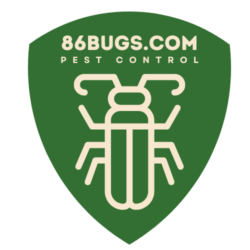Cockroach 101
American Cockroach

American Cockroach
In southern states they are commonly found outdoors, while in the northern states they more frequently take shelter in drains and sewers.
What are American Cockroaches?
American cockroaches are one of the biggest species of roaches common to the household. Coming from Africa and the Middle East, the American cockroach can be found all over the United States. In southern states they are commonly found outdoors, while in the northern states they more frequently take shelter in drains and sewers. Due to their propensity for wet, moist locations, in some regions cockroaches are called other names like the “water roach” or “palmetto bug”.
What Do American Cockroaches Look Like?
Large in and in charge, the American cockroach can range from one to three inches long. Their coloration is typically reddish-brown to a light brown, sporting a yellow band or figure on the top of their head. They have six legs, two straight antennas, and are shaped like an oval. Though one of the few species that uses its wings to fly, this roach still relies heavily on those legs to scurry quickly from point to point.
American Cockroach Behaviors
American cockroaches can fly and move fast. For the most part, you will find cockroaches outdoors in warm, damp locations such as gardens, under mulch, and other types of piles. If the climate proves harsh or food runs out, they move into buildings such as homes, restaurants, small businesses, and other human-made structures.
They also tend to seek out out wet and food-filled areas such as drains, pipes, basements, holes in the wall, and under major appliances. They feed on basically any and all organic materials, from leaves and fungi to crumbs and leftover human food.
American Cockroach Life Cycle
The American cockroach goes through the three stages of metamorphosis like the majority of cockroaches: egg, nymph and adult. The process from birth to fully-formed adult can take anywhere from four to six months. The average lifespan for this particular species is approximately two years.
At its peak ability to reproduce, the female American cockroach can lay from 16 to 32 eggs a week for almost 10 months, making their threat of infestation high.
Signs of American Cockroach Infestations
The common signs that American cockroaches have found a home indoors are similar to its fellow cousins. They include:
- On-sight Visual: If one cockroach is indoors, there is a good chance there are more.
- Droppings: Always eating and always disposing of waste. On counters, in cabinets, or under appliances, American cockroaches will leave little reddish and brown droplets around.
- Eggs: When their babies hatch, the cockroach egg casings that surround the eggs can be found in those similar locations where adults live.
- Odor: Especially when together in a group, American cockroaches give off a wet and musty smell.
How to Get Rid of American Cockroaches
The first step to getting rid of American cockroaches is eliminating their home and food source. Clean your living spaces, especially counters, appliances, sinks, drains and cabinets.
To help keep these pests away in the future, check the foundation and entryways for cracks or holes where they might enter. Caulk or seal these areas and use repellents such as gels to deter re-entry.
These pests are survivalist scavengers, so killing American cockroaches might require options such as traps, baits and pesticides. Since infestations can get out of control quickly with their reproductive abilities, the process for dealing with this species of roach might be slow.
If traditional remedies appear unsuccessful, consult a professional exterminator to provide a plan and solutions unique to your home or business.
American Cockroach Safety
Aside from having your home or business overrun with an unwelcome pest, American cockroaches also carry health concerns. They are excellent transmitters of bacteria, including E. coli and Salmonella. The odors from their secretions are also known to cause problems for people with allergies and asthma. In close contact, these cockroaches are not much of a direct threat. While they can bite, they rarely do, and usually don’t transmit their carriers via their bite.
German Cockroach

German Cockroach
If you ever encountered a cockroach in a home or restaurant, there is a good chance it was a German cockroach. Struggling in colder climates, this pest will seek out shelter and quickly infest their safe haven.
What are German Cockroaches
The German cockroach (Blattella germanica) is the most common species of cockroach worldwide, taking residence in people’s homes, restaurants, nursing homes and hotels. While initial thoughts assumed this roach is a native to Europe, its close relationship and looks to the Asian cockroach suggests its origins might be of southeast Asia. Quickly reproducing and resilient against pest control methods, the German cockroach is one of the most stubborn and difficult pests to deal with.
What Do German Cockroaches Look Like
Much smaller than the American cockroach, the German cockroach grows to less than an inch long, sporting a light-brownish or tannish coloration. With two black stripes on its back, six legs and a pair of antennas, this roach scurries quickly from to place to place. Although they do have wings, they rarely use them to fly.
German Cockroach Behaviors
Unlike some of their counterparts, German cockroaches prefer living indoors. In warm and tropical areas, they will spend more time outdoors. But with an inability to survive harsh and colder environments, expect to find them near or in human structures to live and reproduce.
Of the different cockroach species, the German cockroach is the truest of scavengers, eating almost anything they can get their metaphorical hands on. This includes things such as soap, booking bindings, glue, toothpaste and pet foods in addition to all foods and crumbs left by people.
German Cockroach Life Cycle
The German cockroach goes through the typical three stages of metamorphosis: egg, nymph and adult. The most troublesome aspect of the German cockroach is their reproductive cycle. The females can produce more than 400 eggs during their lifetime, with their average lifespan only being three to six months.
With such a short lifespan, infestations grow quickly since the German cockroach can go from egg to adult in less than ninety days. With females reproducing often and in large amounts, along with a fast metamorphosis, the German cockroach can cause more problems for people than any other roach.
Signs of German Cockroaches
As German cockroaches are most likely to be found indoors, these signs will help guide whether they have penetrated your establishment.
- Visual: If you see a cockroach flashing around food or water sources, there most likely are more around.
- Droppings: German cockroaches leave small, brownish drops of stool where they eat and live.
- Eggs: Females will carry around the egg cases a few days after birth, thus leaving behind these cases where they frequent.
- Odor: German cockroaches leave a musty smell where populations congregate.
How to Get Rid of German Cockroaches
German cockroaches are commonly found indoors in warm and moist places with a consistent food source. Kitchens, bathrooms and basements are their favorites, hiding out in drains, cabinets and appliances.
Because they thrive in dirty, moist locations, the first step to getting rid of and preventing German cockroaches is good sanitation. There are many ways to kill cockroaches: traps, baits, gels, powders and natural solutions.
With their quick and efficient reproductive cycles, the German cockroach is difficult to control. It only takes a few surviving eggs to replenish an infestation.
If your efforts appear unsuccessful, consult with a professional exterminator to provide a plan and solutions unique to your home or business.
German Cockroach Safety
The dirty habits of the German cockroach make them a particular issue for homes and businesses. Their eating habits can contaminate food. Their droppings and pheromones can cause allergy and asthma problems. And they can leave behind bacteria and pathogens harmful to people. The dangers cockroaches can create demand immediate and deliberate action.
Oriental Cockroach

Oriental Cockroach
Good at hiding and fitting into tight locations, the Oriental cockroach (Blatta orientalis) is excellent at reproducing, nesting and infesting inside and outside the home. Pest control efforts will not be easy in removing this particular species of cockroach.
What are Oriental Cockroaches
One of the largest of its kind, the Oriental cockroach is a distinguishable species of roach. Often called the “black beetle cockroach,” they are dark brown to nearly all black in coloration, showcasing a smooth and shiny exterior. Slower than most cockroaches, they prefer to be active outdoors and at night, searching for warm, moist and dark locations to find food and shelter.
What do Oriental Cockroaches Look Like
Not quite as big as the American cockroach, this roach averages about one inch in length. Oriental cockroaches differ in appearance from male to female. The males are slightly shorter (one inch) with stubbed wings, while the females are longer and skinnier (1-1/4 inches) but without wings. Both are reddish-brown to nearly all black.
Oriental Cockroach Behaviors
Unlike some of their counterparts, Oriental cockroaches thrive outdoors and in the environment. Similar to other pests such as earwigs, centipedes, and ants, you can find them under piles of leaves, mulch, stone or wood, along with flower beds and debris build-ups.
Though males have wings, they don’t fly. Both genders are omnivores existing on nearly any type of food source, from decaying plants and rotting garbage to leftover crumbs and people food.
Oriental Cockroach Life Cycle
The Oriental cockroach goes through the three stages of metamorphosis: egg, nymph and adult. An adult has a lifespan of one to six months, mating numerous times. They are seasonal in their reproduction, often producing more eggs in the spring and summer.
Signs of Oriental Cockroaches
Here are some signs Oriental cockroaches are inhabiting the home:
- Seeing them outright.
- Egg cases left around the house.
- A wet or musty smell.
How to Get Rid of Oriental Cockroaches
As with most cockroaches, the first step to getting of them is removing their ideal environment. Keep your home clean and sanitized, especially in wet locations such as drains, pipes, bathrooms or basements, along with any spots where food is present.
Oriental cockroaches particularly like to enter the house in or near doorways or through holes and cracks in the foundation. Seal up these unwanted entryways.
If eliminating entryways and water sources doesn’t solve the problem, look to a professional exterminator for advanced solutions.
Oriental cockroaches can cause additional problems. They transmit bacteria such as E. coli and salmonella, taint food with pathogens, and excrete odors that are problematic for people with allergies and asthma. If an infestation is suspected, take quick action to get rid of and keep the pests out.




